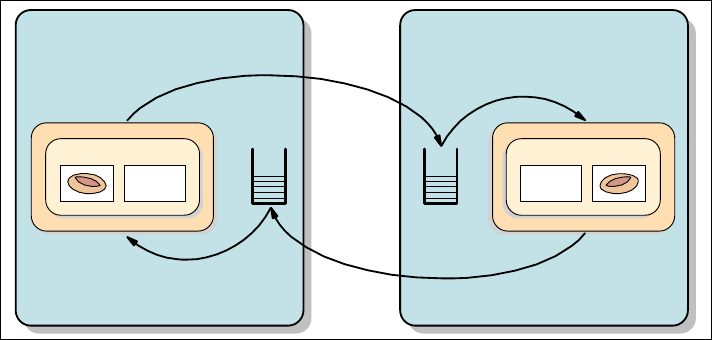
138 Broker Interactions for Intra- and Inter-enterprise
7.5 Java Message Service (JMS)
Messaging middleware is a popular choice for accessing existing enterprise
systems in an asynchronous manner. A standard way of using messaging
middleware from a Java application is using the Java Message Service (JMS)
interface. JMS offers Java programmers a common way to create, send, receive
and read enterprise messages. The JMS specification was developed by Sun
Microsystems with the active involvement of IBM, other enterprise messaging
vendors, transaction processing vendors, and RDBMS vendors.
In IBM WebSphere Application Server V5.0, the J2EE 1.3 specification is
implemented, which includes JMS 1.0 and EJB 2.0.
According to the JMS 1.0 specification, a message provider is integrated in an
application server. As shown in Figure 7-2, the integrated message provider
makes it possible to communicate asynchronously with other WebSphere
applications, without installing separate messaging software like IBM
WebSphere MQ. WebSphere’s integrated JMS server is based on IBM
WebSphere MQ.
Figure 7-2 Integrated JMS Provider
J2EE ServerJ2EE Server
Message
PUT
Message
GET
J2EE Application
Web
Message
GET
Message
PUT
J2EE Application
Web
Chapter 7. Technology options 139
An important new feature of EJB 2.0 is message-driven beans (MDB).
Message-driven beans are designed specifically to handle incoming JMS
messages. Further information on message-driven beans can be found in the
IBM Redbook EJB 2.0 Development with WebSphere Studio Application
Developer, SG24-6819.
7.5.1 What messaging is
Messaging is a form of communication between two or more software
applications or components. One strength of messaging is application
integration. Messaging communication is loosely coupled, as compared to tightly
coupled technologies such as Remote Method Invocation (RMI) or Remote
Procedure Calls (RPC). The sender does not need to know anything about the
receiver for communication. The message to be delivered is sent to a destination
(queue) by a sender component, and the recipient picks it up from there.
Moreover, the sender and receiver do not both have to be available at the same
time to communicate.
JMS has two messaging styles, or in other words, two domains:
One-to-one, or point-to-point model
Publish/subscribe model
7.5.2 JMS and IBM WebSphere MQ
When you want to integrate with an application not based on IBM WebSphere
Application Server V5.0, an external JMS Provider is needed. IBM WebSphere
MQ V5.3 includes built-in JMS Provider support with enhanced performance
features for integrating JMS applications with other applications.
WebSphere MQ enables application integration by allowing business
applications to exchange information across different platforms, sending and
receiving data as messages. WebSphere MQ takes care of network interfaces,
assures once and once only delivery of messages, deals with communications
protocols, dynamically distributes workload across available resources, and
handles recovery after system problems.
7.5.3 Advantages of JMS
The JMS standard is important because:
It is the first enterprise messaging API that has achieved wide cross-industry
support.
It simplifies the development of enterprise applications by providing standard
messaging concepts and conventions that apply across a wide range of
enterprise messaging systems.
Get Patterns: Broker Interactions for Intra- and Inter-enterprise now with the O’Reilly learning platform.
O’Reilly members experience books, live events, courses curated by job role, and more from O’Reilly and nearly 200 top publishers.

